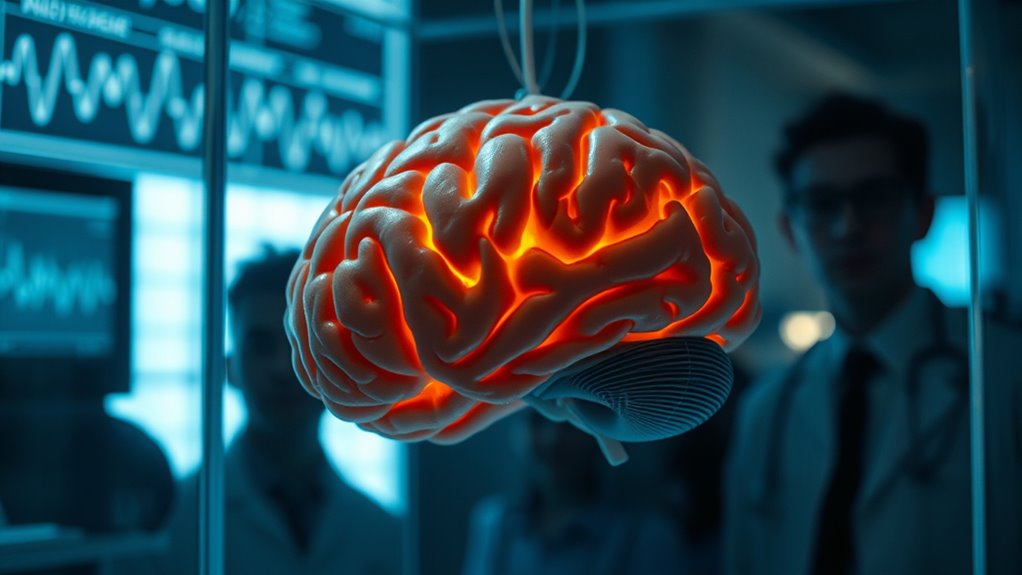Research suggests that consciousness might persist beyond traditional definitions of death. Studies indicate that brain activity can continue after clinical death, and near-death experiences often report vivid sensations, like out-of-body encounters. Sam Parnia’s work highlights the need for exploring these phenomena further. This challenges conventional views on mortality and raises ethical questions about consent in research. You’ll discover fascinating insights that could reshape your understanding of life after death as you go further.
Key Takeaways
- Research indicates that brain activity can persist after clinical death, suggesting consciousness may continue beyond traditional definitions of death.
- Near-death experiences (NDEs) reported by resuscitated individuals often include vivid encounters and transformative feelings, indicating a potential continuation of consciousness.
- Sam Parnia’s studies emphasize the need for further exploration of consciousness, challenging existing views on life after death and the nature of existence.
- Ethical concerns about consent and animal rights arise in studies of consciousness, complicating research efforts related to life after death.
- Philosophical inquiries into non-local consciousness challenge materialistic views, proposing that consciousness may exist independently of the physical brain.
Understanding Death: A Shift in Perspective

While many people view death as a definitive endpoint, recent research challenges this perception by suggesting that our understanding of death might be more socially constructed than we think.
Studies indicate that brain function can persist even after clinical death, raising questions about when consciousness actually ceases. This ongoing brain activity suggests that consciousness exists beyond the traditional definitions of death.
As you explore these findings, consider how near-death experiences reported by resuscitated individuals further complicate our understanding of death.
Advances in resuscitation techniques mean that revival is possible even after being declared dead, prompting crucial discussions about the implications for medical practice and societal beliefs.
This shift in perspective invites you to rethink what it truly means to die.
Sam Parnia’s Research on Near-Death Experiences

Sam Parnia’s groundbreaking research on near-death experiences (NDEs) challenges our understanding of consciousness and its connection to death. As the director of research in this field, he investigates how brain activity may persist longer than previously thought after clinical death.
His studies show that around 10-20% of resuscitated individuals report vivid NDEs, featuring out-of-body experiences and encounters with light, indicating a complex link between consciousness and dying.
Remarkably, Parnia discovered unexpected surges of gamma wave activity in a patient after life support removal, suggesting ongoing brain activity related to consciousness and memory.
His AWARE-TO study, involving over 25 hospitals, emphasizes the need for further exploration into consciousness and its potential existence beyond traditional definitions of life and death.
Biological Insights Into Dying and Consciousness

When you explore the biological insights into dying and consciousness, you’ll find fascinating evidence that brain activity can continue even after clinical death.
This raises questions about what consciousness might look like during those final moments and how near-death experiences might relate to this activity.
Additionally, the ethical considerations of using animal models in this research challenge our understanding of the brain’s role in conscious experience at the edge of life.
Brain Activity After Death
Although we often think of death as the definitive end of consciousness, recent research suggests that brain activity can persist well beyond clinical death.
Studies have shown that after the heart stops, there can be surges of gamma wave activity indicative of complex processes still occurring in the brain. This challenges traditional views about the immediate cessation of brain function.
- Significant brain activity can occur post-mortem.
- Consciousness experiences may happen even after clinical death.
- Yale research found metabolic activity in pig brains after death.
- A notable percentage of resuscitated individuals report vivid near-death experiences.
These findings imply that consciousness mightn’t be strictly tied to biological brain function, opening new avenues for understanding life after death.
Consciousness and Near-Death Experiences
Understanding consciousness during near-death experiences (NDEs) offers fascinating insights into the dying process and what might happen beyond clinical death.
Research shows that about 10-20% of people who are resuscitated report vivid NDEs, featuring out-of-body experiences and life reviews.
Curiously, modern studies using advanced MRI and EEG machines reveal a surge in brain activity shortly after clinical death, suggesting that consciousness may persist longer than we thought.
Jimo Borjigin’s findings of neurotransmitter storms in the dying brain further indicate complex brain activity during this time.
Sam Parnia’s work challenges traditional definitions of death, proposing that consciousness could exist independently of brain activity, reshaping our understanding of life after death and its potential implications.
Ethical Considerations in Research
As researchers explore the biological insights of dying and consciousness, ethical considerations emerge as critical components of their studies.
The scientific literature reveals that brain activity may persist longer than previously thought, raising ethical concerns about how we approach dying patients. You should consider the following:
- The collaboration with slaughterhouses to source brain tissue for research raises questions about consent and animal rights.
- Sudden surges in brain activity post-death challenge our understanding of consciousness and suffering.
- The continuum of life to death emphasizes the need for ethical guidelines in resuscitation practices.
- Understanding brain connectivity during dying processes highlights potential consciousness beyond observable brain function.
These ethical considerations are essential in ensuring respectful and humane research practices in the quest for understanding life after death.
Ethical Considerations in Death Research

When you explore death research, you’ll quickly notice the ethical concerns surrounding collaboration with slaughterhouses and the use of animal brains.
It raises questions about informed consent and the moral implications of animal testing in understanding human consciousness.
These complexities demand careful consideration as you navigate the boundaries between science and ethics.
Researcher Collaboration Concerns
Although ethical considerations in death research are often overshadowed by scientific curiosity, they play an important role in shaping how researchers collaborate.
When investigating consciousness and near-death experiences, you must be aware of significant factors:
- Sourcing brain tissue from animals raises treatment and ethical concerns.
- Collaborations with slaughterhouses necessitate transparency and ethical oversight.
- The potential revival of consciousness leads to questions about consent and individual rights.
- Stigmas surrounding paranormal elements make funding for these studies challenging.
Navigating these ethical considerations guarantees that research maintains human dignity while addressing the complexities of consciousness.
Ultimately, a robust ethical framework is essential for guiding experimental designs and interpretations in this sensitive field.
Animal Testing Ethics
While exploring the ethics of animal testing in death research, you’ll encounter significant moral dilemmas that challenge our understanding of consciousness and suffering.
The practice of sourcing brain tissue from animals, like pigs, raises ethical considerations about their treatment and the justification of such actions for scientific progress.
Collaborations with slaughterhouses to obtain post-mortem tissue prompt questions about the potential suffering animals endure during experimentation.
Although studies showing restored brain function can provide insights, they also highlight concerns regarding sentience and the humane treatment of test subjects.
Ethical guidelines emphasize minimizing harm, necessitating scrutiny of practices that intersect scientific inquiry and moral obligations, especially in research that questions traditional views on life and death.
Informed Consent Challenges
The ethical landscape in death research is further complicated by the challenges of obtaining informed consent, particularly from patients in critical or terminal conditions. Their ability to comprehend and agree may be compromised, raising significant ethical considerations.
Researchers must navigate these complexities while exploring consciousness after clinical death. Key issues include:
- The necessity of clear consent processes for studies on near-death experiences.
- Ethical dilemmas in resuscitation studies where patients may not have consented to experimental procedures.
- Concerns regarding animal subjects when sourcing brain tissue from slaughterhouses.
- The need for established guidelines as the definitions of life and death evolve.
These informed consent challenges underscore the importance of ethical rigor in research surrounding life after death.
The Role of Brain Activity Post-Mortem

As scientists explore the mysteries of consciousness, emerging evidence suggests that brain activity can persist even after death.
Modern studies utilizing MRI and EEG technology reveal surges of high-frequency electrical activity shortly post-mortem, particularly in areas associated with consciousness and dreaming.
Research led by Sam Parnia indicates that brain function may continue for an extended time after clinical death, challenging the belief that consciousness ceases immediately.
Importantly, findings from Patient One show unexpected brain activity after life support removal.
Additionally, experiments on pigs demonstrate that brain cells can remain metabolically active post-mortem.
These results raise profound questions about consciousness during clinical death, suggesting that the dying brain may still exhibit complex functions contrary to traditional views on death.
Common Features of Near-Death Experiences

When you explore near-death experiences, you’ll find some fascinating common features.
Many people report out-of-body experiences, life reviews, and encounters with light that leave a lasting impact.
These elements not only shape their narratives but also spark curiosity about what happens after we die.
Out-of-Body Experiences
While many people might dismiss near-death experiences (NDEs) as mere hallucinations, a significant number of those who’ve been resuscitated report vivid out-of-body experiences.
During these moments, individuals often describe feeling detached from their physical bodies, observing their surroundings in detail. This phenomenon raises intriguing questions about consciousness and brain activity.
Key characteristics of out-of-body experiences include:
- Sensation of floating above the physical body
- Vivid imagery and emotional interactions
- Reports of familiar figures or guides
- Transformative feelings post-experience
Research indicates these experiences often occur during clinical death or extreme physiological distress, suggesting a complex relationship between brain activity and subjective experiences.
This challenges traditional views on consciousness, hinting that it might persist beyond the cessation of brain function.
Life Reviews
Many who’ve had near-death experiences (NDEs) report a powerful phenomenon known as a life review, where you relive significant moments from your life with striking clarity.
During these experiences, you might encounter profound emotional insights about your actions and how they’ve impacted others. Research indicates that 10-20% of resuscitated individuals recount life reviews, often marked by feelings of unconditional love, forgiveness, and a deeper understanding of personal choices.
The AWARE-TO study, involving over 25 hospitals, highlights the vividness of these reviews during clinical death.
Raymond Moody’s influential book, “Life After Life,” first documented these transformative experiences, suggesting that life reviews are a universal aspect of consciousness across cultures, providing deep reflections on life’s meaning.
Encounters With Light
What’s it like to encounter light during a near-death experience? Many people describe it as a warm, loving presence that envelops them, often during moments of clinical death.
These encounters with light are one of the most consistent features of near-death experiences, and they resonate across various cultures and religions.
Here are some key aspects of these encounters:
- Warmth and Love: Individuals feel an overwhelming sense of comfort.
- Universal Descriptions: Similar experiences reported worldwide, regardless of background.
- Emotional Connections: People relive significant moments and interactions.
- Scientific Interest: Ongoing research seeks to understand the neurological and psychological mechanisms behind these phenomena.
These elements suggest that encounters with light may hold deeper significance in our understanding of life after death.
Historical Context of Near-Death Studies

Since the early 18th century, interest in near-death experiences (NDEs) has evolved, reflecting a blend of curiosity and scientific inquiry.
Interest in near-death experiences has transformed since the 18th century, merging curiosity with scientific exploration.
Early speculations linked NDEs to physiological changes in the brain during traumatic events, paving the way for deeper exploration.
In 1892, Albert Heim documented systematic accounts of NDEs, revealing common themes like life reviews and serene imagery.
The 1975 publication of Raymond Moody’s “Life After Life,” which analyzed experiences of 150 near-cardiac arrest patients, sparked significant scientific interest and popularized the concept.
The establishment of the International Association for Near-Death Studies in 1977 marked an important shift toward scientific legitimacy, leading to a surge in research output from 17 articles between 1975 and 1984 to over 221 in the last decade.
Challenges in Researching Consciousness and Death

Researching consciousness and death presents a unique set of challenges that complicate our understanding of near-death experiences (NDEs).
These obstacles hinder scientific progress and funding, making it difficult to study this fascinating phenomenon effectively. Key challenges include:
- Stigma surrounding paranormal phenomena affects research legitimacy.
- Lack of control groups limits the ability to verify NDE experiences.
- Elusive empirical evidence for consciousness existing post-death remains a significant hurdle.
- Intersection of scientific inquiry with philosophical and theological debates complicates definitions and frameworks.
Despite recent advancements, like studies showing post-mortem brain activity, more research is essential to bridge the gaps between neuroscience and the mysteries of consciousness and death.
Addressing these challenges is vital for a clearer understanding of NDEs.
The Philosophical Implications of Life After Death

As we explore the philosophical implications of life after death, we confront fundamental questions about the nature of consciousness and its relationship to the physical body. The debate centers around whether consciousness must be seen as a product of the brain or an independent entity. Near-death experiences challenge conventional views, suggesting consciousness may persist beyond biological death.
| Philosophical Questions | Implications for Understanding Life After Death |
|---|---|
| Is consciousness separate? | Potential continuity of existence |
| What is the afterlife? | Ethical reflections on life and death |
| Is consciousness cyclical? | Redefining human experience |
| How do cultures perceive it? | Universal questions across societies |
| What is the purpose of life? | Engaging deeply with mortality |
These inquiries encourage profound reflections on existence and purpose.
Future Directions in Death and Consciousness Research

Exploring the philosophical implications of life after death opens the door to future directions in death and consciousness research.
As you investigate this new science of death, consider these emerging areas of exploration:
- Investigating brain activity during near-death experiences (NDEs) to understand conscious experience
- Reevaluating definitions of death in light of advances in resuscitation techniques
- Exploring the potential of “non-local” consciousness beyond the physical brain
- Encouraging interdisciplinary dialogue between neuroscience and spirituality
These avenues promise to challenge traditional views of consciousness cessation and may lead to imminent breakthroughs.
Despite funding challenges and societal stigma, ongoing research could reshape our understanding of life beyond death, bridging subjective experiences with empirical scientific inquiry.
Frequently Asked Questions
Is There Life After Death According to Science?
When you ask if there’s life after death according to science, the answer isn’t clear-cut. Current research hasn’t provided definitive proof.
However, studies on near-death experiences show that some individuals report vivid encounters during clinical death. These experiences, combined with recent findings on brain activity post-death, suggest consciousness might persist in some form.
Still, the scientific community emphasizes the need for further exploration and remains skeptical about confirming an afterlife.
Is There a Concept of Life After Death?
You might think of life after death as a gentle journey into the unknown, where the soul continues beyond the physical domain.
Many cultures and philosophies embrace this idea, suggesting a continuity of existence.
You’ve likely heard stories of near-death experiences, where individuals describe encounters with light and profound revelations.
While these accounts spark curiosity, they remain largely speculative, inviting you to ponder the mysteries of consciousness and what lies beyond our earthly lives.
Where Does Our Soul Go After Death?
You might wonder where your soul goes after death. Many cultures and beliefs suggest various destinations, like heaven, reincarnation, or merging with the universe.
Some people feel that your consciousness could transcend physical existence, experiencing a continuation beyond the body. Others argue that your soul may simply cease to exist.
Ultimately, the answer varies based on personal beliefs, spiritual teachings, and experiences, leaving you to explore what resonates with you the most.
How Many Days Does a Soul Stay After Death?
When a loved one passes, you might wonder how long their essence lingers.
While traditions suggest a soul could stay for days or even weeks, there’s no definitive answer.
Feelings of detachment during near-death experiences hint at timelessness, but the duration remains a mystery.
Cultural beliefs vary widely, and without scientific proof, it’s challenging to pin down how long a soul truly hangs around after leaving its earthly home.
Conclusion
As you ponder the mysteries of life after death, remember the words of Shakespeare: “There are more things in heaven and earth than are dreamt of in your philosophy.” The research on near-death experiences and consciousness invites you to question your beliefs and embrace the unknown. While the evidence remains inconclusive, the quest for answers continues to inspire hope and curiosity, reminding us that the journey beyond may hold secrets yet to be uncovered.









